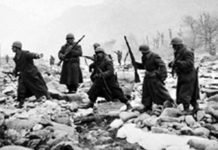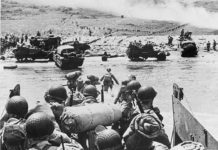
From ancient Egypt and Persia to Europe in World War II, cats were used in warfare as shields, gas detectors and early warning systems for bombs.
From elephants to horses, dogs to pigeons, animals have found themselves conscripted during times of war. Some were used for transportation, others to deliver messages. For over 2500 years, cats played a role in warfare – often at a high price to themselves.
Persians Used Cats Against Egyptians
One of the earliest recorded instances of cats being used in war occurred during the battle of Pelusium in 522 BC. Cambyses II, the King of Persia, knew how greatly his Egyptian foes revered cats. In some accounts, he and his soldiers captured several cats and used them as shields in their attack on the city of Pelusium. In other accounts, the Persians simply set cats loose on the battlefield.
Either way, because it was against Egyptian law to hurt or kill a cat, the Egyptian soldiers couldn’t fight back without risking the accidental death of one of the cats. They did the only thing they could: they surrendered the city to the Persian force.
Cats Spread and Detect Poisonous Gas
Cats played a dual role in terms of poisonous gases used during war.
In 16th century Germany, artillery officer Christopher of Hapsburg presented a plan to the Council of One and Twenty in Strasbourg to use cats to spread poisonous gas among enemy soldiers. To turn cats into feline gas bombs, he suggested attaching jars filled with poison gas to the cats’ back. Once the cats were equipped, they would be driven into enemy positions. As the cats ran, the jars would release their poisonous vapors, killing the enemy.
Luckily for the cats, the plan was never put into use, though a copy of his drawing still exists in Strasburg. Other cats weren’t so lucky.
In World War I, the British army employed upwards of 500,000 cats as ratters but also as mobile gas detectors, much like miners used canaries to warn them of gas leaks. Because the cats were so much smaller than soldiers, they would feel the effects of the gas faster, giving the soldiers time to react. As for the cats, there are no records regarding how many survived their conscription into the military.
Cats Used as Early Warning System for Bombs
Although today’s military uses sniffer dogs to sniff out explosives, cats have their own built-in bomb detectors. Whether they are simply attuned to changes in atmospheric pressure or they have a sixth sense, some cats are particularly good at knowing when a bomb is about to hit.
During World War II, families soon learned to follow their cats into bomb or air-raid shelters, saving many lives. Among the most famous cats was one appropriately named Bomber. This cat could distinguish between the sounds made by RAF and German aircraft from a surprising distance. When Bomber headed for shelter, his family followed, making him a feline early warning system.
Although today, most military cats are mascots, they still play an important part in keeping morale high.
Sources:
- Roni Jay. The Kingdom of the Cat Firefly Books. 2000.
- Pawsonline.info. “Cats Used In Warfare.”
- Oddee.com. “9 Absolutely Insane Weapons of War.”
- Purr-n-fur.org. “Cats in Wartime.”







